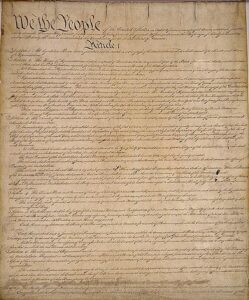
by Wilton H. Strickland
The U.S. Supreme Court recently handed down three decisions that have ignited a firestorm of controversy, which is understandable because they concern what many people regard as fundamental rights: abortion, freedom of religion, and the right to keep and bear arms. I am not going to explore the social or political aspects of these rulings, since that is far beyond the scope of this blog. Instead, I am going to explore the legal thread that connects them all, which is the Fourteenth Amendment.
The Fourteenth Amendment was adopted in the wake of the Civil War as part of a civil-rights “package” that included the abolition of slavery (the Thirteenth Amendment) and the abolition of race-based voting restrictions (the Fifteenth Amendment). What the Fourteenth Amendment seeks to accomplish in its core provision is to prohibit the States from denying “due process of law” or “equal protection of the laws.” This language is rather vague and opens a Pandora’s Box of potential litigation, so just five years after its adoption the Supreme Court explained in the Slaughter-House Cases that it had a narrow purpose: to guarantee that the former slaves and their descendants possessed the same civil rights as everyone else (e.g., the right to enter contracts, to own property, to travel freely, to serve on juries, etc.). The Court emphasized that the Fourteenth Amendment did not create new rights or entitle any Tom, Dick, or Harry to run to federal court to attack a State’s laws, since this would upend the constitutional order:
Was it the purpose of the fourteenth amendment . . . to transfer the security and protection of all the civil rights which we have mentioned, from the States to the Federal government? . . . [S]uch a construction . . . would constitute this court a perpetual censor upon all legislation of the States, on the civil rights of their own citizens, with authority to nullify such as it did not approve as consistent with those rights, as they existed at the time of the adoption of this amendment. . . . [T]hese consequences are so serious, so far-reaching and pervading, so great a departure from the structure and spirit of our institutions; . . . the effect is to fetter and degrade the State governments by subjecting them to the control of Congress, in the exercise of powers heretofore universally conceded to them of the most ordinary and fundamental character . . . .
We repeat, then, in the light of this recapitulation of events, almost too recent to be called history, but which are familiar to us all; and on the most casual examination of the language of these amendments, no one can fail to be impressed with the one pervading purpose found in them all, lying at the foundation of each, and without which none of them would have been even suggested; we mean the freedom of the slave race, the security and firm establishment of that freedom, and the protection of the newly-made freeman and citizen from the oppressions of those who had formerly exercised unlimited dominion over him
In other words, the Fourteenth Amendment was restricted to its historical context and purpose. This is the same approach that the Court has taken with regard to the Thirteenth Amendment, whose language prohibiting “involuntary servitude” could conceivably nullify jury duty, truancy laws, or the draft if taken literally and without context. Oddly, the Court in later years chose to abandon its restraint with regard to the Fourteenth Amendment despite continuing to exercise restraint with regard to the Thirteenth, an inconsistency that bedevils us to the present day.
One way the Court did this was to “incorporate” the Bill of Rights one at a time into the Fourteenth Amendment and treat those rights as restrictions against the States, even though it was well known that the Bill of Rights had been adopted as a safeguard only against the federal government (as held by the famous Chief Justice John Marshall in Barron v. Baltimore). For example, the First Amendment (which is directed only at Congress) was once considered absolute against the federal government but totally inapplicable to the States, who frequently restricted speech or endorsed religion in whatever way their citizens saw fit. The same went for the Second Amendment, which absolutely forbade the federal government from regulating arms but left the States free to do so in the interest of preserving “a well-regulated militia.” This clear distinction between (broad) state power and (narrow) federal power gradually eroded as the Supreme Court continued “incorporating” more rights against the States, a process that also diluted those rights as the Supreme Court carved out novel exceptions and balancing tests that appear nowhere in the constitutional text. Pandora’s Box had been opened, and endless litigation has flowed out of it ever since.
Another way the Court abandoned its restraint was to embrace the nebulous doctrine of “substantive due process,” whereby the Court would invoke the Fourteenth Amendment to strike down state laws even if the hallmarks of due process had been followed (e.g., adequate notice and a fair hearing on the merits). According to the Court, if the substance of a law offends traditional notions and customs (as divined by the Court), the law must fail. This represented a total repudiation of the Court’s initial approach to the Fourteenth Amendment, as well as the elevation of the Court members to philosopher kings with power to veto the will of the people for virtually any reason.
Which brings us to the three recent decisions regarding abortion, God, and guns. The Court held in Dobbs v. Jackson Women’s Health Organization that the Fourteenth Amendment does not prohibit States from regulating or even outlawing abortion, but the Court also held that the Fourteenth Amendment does prohibit States from excessively regulating prayer in public schools (Kennedy v. Bremerton School District) and does prohibit States from excessively regulating arms ownership (New York State Rifle & Pistol Assoc., Inc. v. Bruen).
The Court explains these inconsistent rulings by noting that abortion is not specifically mentioned in the Constitution, but that freedom of religion is (in the First Amendment) and the right to bear arms is (in the Second Amendment). This is a distinction that would have been lost on the Court’s previous members when initially interpreting the Fourteenth Amendment, since that interpretation would reserve all of these matters to the States to work out for themselves. Under the Constitution as written and intended, States may regulate anything unless specifically prohibited from doing so, such as in Article I, Section 10 (prohibiting ex post facto laws, bills of attainder, impairment of contracts, etc.). Neither the Bill of Rights nor “substantive due process” is among the constitutional restrictions against the States, at least not as originally intended. For a Court that is often accused of following “original intent,” it has not done so here.
The judicial interpretation of a law that occurs shortly after the law’s passage is customarily entitled to deference. For whatever reason, that custom has vanished with regard to the Fourteenth Amendment, whose contours are constantly shifting and remain unpredictable depending on what type of people occupy the Court. Who knows what might happen next?


